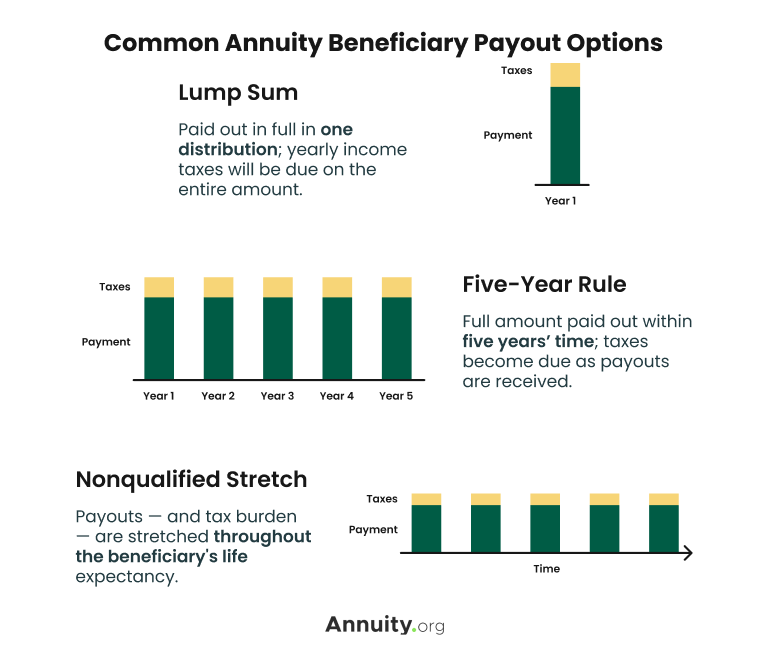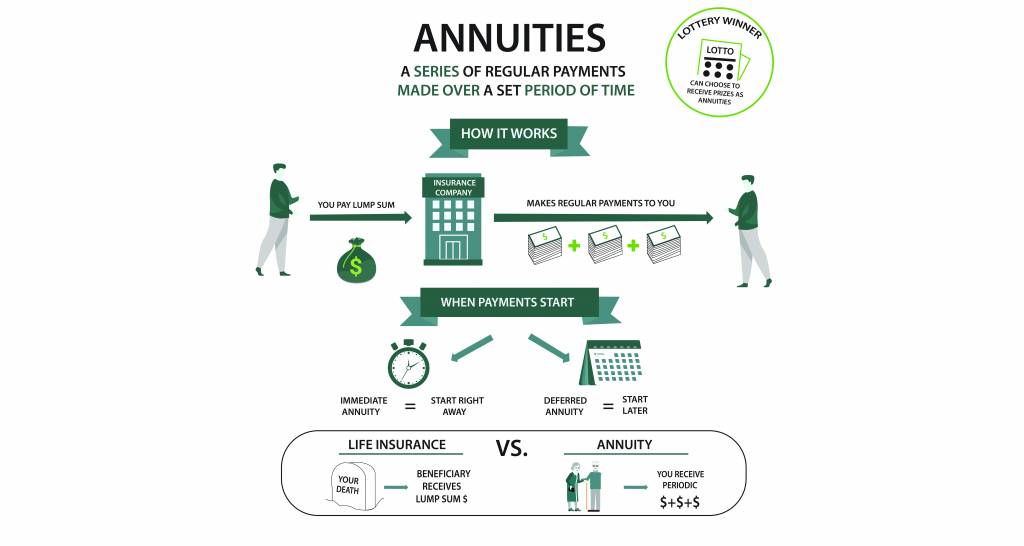All Categories
Featured
Table of Contents

Comprehending the different fatality benefit choices within your acquired annuity is very important. Carefully examine the agreement information or consult with a financial advisor to figure out the specific terms and the very best way to continue with your inheritance. Once you inherit an annuity, you have a number of alternatives for receiving the cash.
In many cases, you could be able to roll the annuity into an unique kind of specific retired life account (INDIVIDUAL RETIREMENT ACCOUNT). You can choose to receive the whole remaining balance of the annuity in a solitary repayment. This option offers instant accessibility to the funds yet comes with major tax repercussions.

If the inherited annuity is a certified annuity (that is, it's held within a tax-advantaged pension), you may be able to roll it over right into a brand-new pension. You don't need to pay tax obligations on the rolled over quantity. Beneficiaries can roll funds right into an acquired individual retirement account, a distinct account particularly designed to hold assets inherited from a retirement.
Annuity Beneficiary and inheritance tax
Other types of recipients usually have to take out all the funds within one decade of the proprietor's death. While you can't make additional payments to the account, an acquired IRA uses an important advantage: Tax-deferred development. Earnings within the inherited individual retirement account accumulate tax-free until you start taking withdrawals. When you do take withdrawals, you'll report annuity earnings in the same method the plan participant would certainly have reported it, according to the internal revenue service.
This alternative supplies a steady stream of income, which can be beneficial for long-lasting economic preparation. There are different payout options offered. Normally, you should start taking circulations no more than one year after the proprietor's death. The minimal amount you're called for to withdraw yearly after that will be based upon your very own life span.

As a recipient, you won't be subject to the 10 percent IRS early withdrawal penalty if you're under age 59. Trying to compute tax obligations on an inherited annuity can feel intricate, but the core concept focuses on whether the contributed funds were formerly taxed.: These annuities are moneyed with after-tax dollars, so the beneficiary generally does not owe taxes on the original payments, but any kind of revenues collected within the account that are dispersed go through ordinary income tax obligation.
How are Structured Annuities taxed when inherited
There are exemptions for partners who acquire qualified annuities. They can normally roll the funds into their own individual retirement account and delay tax obligations on future withdrawals. In any case, at the end of the year the annuity company will certainly file a Kind 1099-R that demonstrates how much, if any type of, of that tax obligation year's circulation is taxable.
These tax obligations target the deceased's total estate, not just the annuity. These taxes commonly just impact really huge estates, so for the majority of beneficiaries, the emphasis needs to be on the income tax obligation implications of the annuity.
Annuity Income Riders death benefit tax
Tax Obligation Therapy Upon Death The tax obligation therapy of an annuity's fatality and survivor advantages is can be fairly complicated. Upon a contractholder's (or annuitant's) death, the annuity may undergo both earnings taxes and inheritance tax. There are different tax obligation therapies relying on that the beneficiary is, whether the proprietor annuitized the account, the payment method chosen by the beneficiary, and so on.
Estate Taxation The government inheritance tax is a highly dynamic tax (there are many tax braces, each with a higher price) with rates as high as 55% for really huge estates. Upon death, the IRS will include all building over which the decedent had control at the time of death.
Any kind of tax in extra of the unified debt is due and payable 9 months after the decedent's death. The unified debt will fully shelter relatively small estates from this tax.
This conversation will certainly concentrate on the inheritance tax treatment of annuities. As held true throughout the contractholder's life time, the internal revenue service makes a vital distinction between annuities held by a decedent that are in the buildup phase and those that have actually gotten in the annuity (or payment) stage. If the annuity remains in the build-up phase, i.e., the decedent has not yet annuitized the contract; the complete fatality benefit assured by the contract (consisting of any boosted survivor benefit) will certainly be included in the taxable estate.
Inherited Annuity Rates taxation rules
Example 1: Dorothy had a repaired annuity agreement provided by ABC Annuity Firm at the time of her death. When she annuitized the agreement twelve years back, she picked a life annuity with 15-year period particular. The annuity has been paying her $1,200 monthly. Because the agreement guarantees payments for a minimum of 15 years, this leaves 3 years of settlements to be made to her boy, Ron, her marked beneficiary (Annuity fees).

That worth will be consisted of in Dorothy's estate for tax obligation objectives. Think rather, that Dorothy annuitized this contract 18 years earlier. At the time of her fatality she had actually outlived the 15-year duration specific. Upon her fatality, the repayments stop-- there is absolutely nothing to be paid to Ron, so there is absolutely nothing to consist of in her estate.
Two years ago he annuitized the account picking a life time with money refund payout alternative, calling his daughter Cindy as beneficiary. At the time of his fatality, there was $40,000 major remaining in the contract. XYZ will certainly pay Cindy the $40,000 and Ed's administrator will certainly include that quantity on Ed's inheritance tax return.
Since Geraldine and Miles were wed, the benefits payable to Geraldine represent residential property passing to a making it through spouse. Annuity death benefits. The estate will certainly be able to use the limitless marriage deduction to avoid taxes of these annuity advantages (the worth of the advantages will be detailed on the estate tax obligation kind, along with a balancing out marital deduction)
Tax consequences of inheriting a Lifetime Annuities
In this situation, Miles' estate would certainly include the worth of the continuing to be annuity settlements, however there would be no marital reduction to balance out that addition. The very same would apply if this were Gerald and Miles, a same-sex couple. Please keep in mind that the annuity's staying worth is established at the time of death.

Annuity agreements can be either "annuitant-driven" or "owner-driven". These terms describe whose death will certainly cause repayment of death benefits. if the contract pays survivor benefit upon the death of the annuitant, it is an annuitant-driven contract. If the death advantage is payable upon the death of the contractholder, it is an owner-driven contract.
There are situations in which one individual owns the agreement, and the gauging life (the annuitant) is a person else. It would certainly be good to believe that a certain agreement is either owner-driven or annuitant-driven, however it is not that straightforward. All annuity contracts provided given that January 18, 1985 are owner-driven since no annuity contracts issued ever since will certainly be granted tax-deferred standing unless it consists of language that activates a payment upon the contractholder's fatality.
Table of Contents
Latest Posts
Understanding Financial Strategies Key Insights on Fixed Interest Annuity Vs Variable Investment Annuity Defining the Right Financial Strategy Pros and Cons of Various Financial Options Why Fixed Annu
Highlighting Retirement Income Fixed Vs Variable Annuity A Comprehensive Guide to Investment Choices What Is Fixed Annuity Vs Equity-linked Variable Annuity? Features of Fixed Vs Variable Annuities Wh
Breaking Down Fixed Vs Variable Annuity Pros Cons A Closer Look at How Retirement Planning Works Defining the Right Financial Strategy Benefits of Choosing the Right Financial Plan Why Choosing the Ri
More
Latest Posts